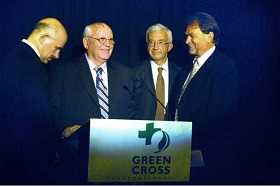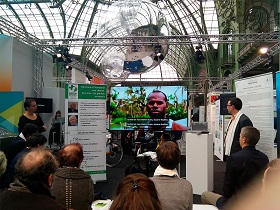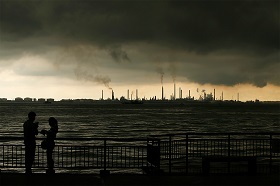We Live As If We Don’t See History
Green Cross Project ‘Smart Water for Green
Schools’
(no votes) |
(0 votes) |
The UN has officially declared 2016 to be the hottest year in the history of mankind. This means that problems associated with ecology and the environment will inevitably ascend from secondary positions on the international agenda to among the leading ones. The ratification of the Paris Agreement by three of the most problematic players in this regard – the United States, China and India – signifies a revolutionary breakthrough. The work performed by environmental organizations is now more important now than ever. Alexander Likhotal, the president of the Green Cross International non-profit organization, shared his vision of the environmental problems the planet faces as well as issues involving the further development of mankind.
The UN has officially declared 2016 to be the hottest year in the history of mankind. This means that problems associated with ecology and the environment will inevitably ascend from secondary positions on the international agenda to among the leading ones. The ratification of the Paris Agreement by three of the most problematic players in this regard – the United States, China and India – signifies a revolutionary breakthrough. The work performed by environmental organizations is now more important now than ever. Alexander Likhotal, the president of the Green Cross International non-profit organization, shared his vision of the environmental problems the planet faces as well as issues involving the further development of mankind.
Why did the desire to set up such an organization arise specifically in 1993?
Mikhail Gorbachev wanted to set it up even earlier than that. In 1990, a major conference ‘For the Survival of Mankind’ was held in Moscow. It was attended by prominent figures from all around the world, such as Alvin Toffler, among others, who were setting the trends for the future. Speaking at the conference, Gorbachev said: “Now that we have made some progress in the area of nuclear disarmament, it is time to focus on environmental problems. These are the problems that will pose a major threat to mankind”. The statement would later serve as the foundation of the Green Cross – an organization that was set up based on the image and likeness of the Red Cross, but for environmental issues instead.
Following the collapse of the USSR and Gorbachev’s resignation in 1992, I heard a news report on the radio indicating that a Green Summit had been held in Rio de Janeiro at which Gorbachev had been elected as president of the Green Cross. At the time, sceptical of this initiative since the environment was far from being a major focus of the international community, I tried to dissuade Gorbachev from taking this position. Fortunately, this did not happen. Even then it had become obvious that global problems were not limited to security issues and the political sphere. This is how the Green Cross started being built, and in 1993 the organization started functioning.
What sets the Green Cross apart from other organizations that deal with environmental problems?
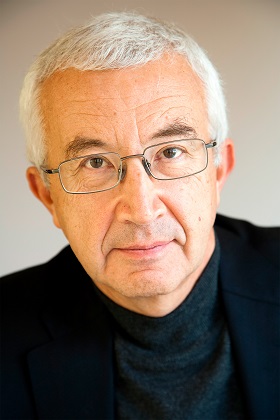
Alexander Likhotal
The limited focus of the organization’s activities. Today there are numerous organizations that deal with the entire variety of environmental problems. The Green Cross primarily focuses on issues in areas where the environment, security and the fight against poverty overlap. This is a distinguishing feature of the organization. When people ask me what I consider the biggest and most important achievement of the Green Cross, I always reply that we were able to gain UN recognition specifically due to this combined and clear approach to problems.
The situation used to be completely different. Following the Persian Gulf War in 1990-1991, we conducted a study identifying the enormous damage that has been done to the environment. This inevitably had a negative effect on people as well. When the Green Cross appealed to the UN, we were rejected since at the time the issue of resolving the humanitarian crisis was among the most pressing items on the agenda. Little by little we managed to reverse this perception. Now humanitarian disasters and environmental impacts are always considered as a unified whole.
In 1994, the Joint UNEP/OCHA Environment Unit was established. This organization focuses specifically on considering such joint problems. I believe this was an intellectual revolution in this regard just like the establishment of the Red Cross was at one time. Before the Red Cross was founded, it was not customary to help wounded enemy soldiers in the battlefield. The Red Cross founders carried out a revolution in the humanitarian sphere. At a conceptual level, the Green Cross has carried out a similar revolution in the perception of environmental problems.
Does the Green Cross cooperate with other organizations, such as the UN or the International Committee of the Red Cross?
Of course. The Green Cross works closely with the UN, the Office for the Coordination of Humanitarian Affairs (OCHA) and the Joint Unit mentioned above. For instance, when the tsunami in South Asia occurred in 2004, our Pakistani organization provided information about the damage, which the UN then requested from us. There were no official documents, and we were happy to share the data we had received. The Green Cross also works in Vietnam, where children are born with deformities of the bone tissue as a result of a decrease in carbon dioxide in the food chain. Due to religious peculiarities in Vietnam, this phenomenon is regarded as punishment for sins committed in a previous life. Thus, children not only suffer from a physiological disease, but from social pressure as well and are treated like outcasts. The Green Cross found a solution to the situation by providing an orthopaedic corset to each child suffering from this disease. If a child wears this corset until the age of three months, the disease subsides and the bones recover. One corset costs a hundred dollars. Collectively, we are talking about small amounts here. People in the United States have taken a great interest in this problem, thus we have received a large part of the sponsorship money used to help Vietnamese children from there. In this case, there was no issue of who to blame. The goal was to help people who are suffering from the environmental impacts of military activities. This is the most important thing.
How does the organization make decisions on whom to provide aid to and which countries to work in? Does the decision depend on the organization’s donors?
No. The Green Cross has a very rigid principle – to prevent the tail from wagging the dog. If a donor starts giving conditions, we cease cooperation. I must say that we have very rarely seen attempts to put pressure on our activities. There are other factors that can have an impact – when a particular disaster occurs somewhere in the world, the media’s interest inevitably focuses on these events. And while the cameras are rolling, donors are literally queueing up to help. This creates psychological pressure. Clearly, the issue of fundraising is always a pressing one for any non-governmental organization, and there is a desire in this regard to replenish your budget in the wake of such events. We always try to correlate our strategic policy and potential opportunities in terms of whether they fit in with our mission or not.
Does the Green Cross work with COP21? Will it facilitate the fulfilment of the obligations undertaken by the agreement’s member nations?
Of course. The Green Cross has a consultative status with many organizations in the UN system (ECOSOC, UNEP, UNESCO) and we also work closely with countries as part of the UN Framework Convention on Climate Change. To this end, Green Cross established a special high-level working group that includes politicians, UN representatives and businessmen. We took part in the Paris Conference in December 2015, and we will be in Marrakech in November 2016.
I believe a breakthrough was achieved in Paris even though no fundamental changes occurred from the standpoint of international law and the fight against CO2 emissions because even if all the commitments identified in Paris are fulfilled, by 2030 CO2 emissions will nevertheless be 7 billion tonnes more than what is permissible to avoid exceeding the warming threshold of two degrees. On the other hand, this agreement signified a step towards the future. It’s not a rigid agreement and does not provide for any punitive measures. It is based on a voluntary system of mutually stimulating member nations as well as the inclusion of nation states in addition to business, non-governmental organizations and civil society in this process. As a result, this creates preconditions for moving forward. Already now, we have 60 countries (including such major ones in terms of emissions as the United States, China and India) accounting for 47.5% (of greenhouse gas emissions around the world). We only need 7.5% more for the agreement to take effect. Russia has also begun playing a very active role in recent years.
I think that by the next conference in Marrakech the parties will be able to reach an agreement on the Agreement taking effect. Thus, we are witnessing the creation of a model for the international management of a complex integrated problem that features environmental, economic and political aspects. Of course, establishing a rigid system of regulation for the almost 200 nations around the world would be a utopia. What we have right now gives hope for moving forward.
What area of the organization’s work is the most important?
As the president of the organization, it’s difficult for me to give a preference to a particular aspect of our work. They are all important. However, I am very impressed with the Green Cross’s activities in resolving water-related problems. This is very specific, grounded work with a clear result.
Today, roughly half the world’s hospital beds are filled with patients suffering from ailments caused by bad water. Approximately 70% of the world’s schools lack clean water. This is a catastrophe. In several African countries, girls aren’t allowed to go to school because each day they have to walk up to five kilometres to a source of water and return home with a full jug of water. There is no time for studies. The Green Cross established a project called ‘Smart Water for Green Schools’ and is working on implementing this program in West Africa (Burkina Faso, Ghana and Côte d'Ivoire), Latin America and China.
The project is extremely simple in terms of how it works. The Green Cross chooses a school located in a remote area where there is no access to water and no sanitary and sewerage systems and provides it with clean water. In Africa, we have to drill deep wells that go much deeper than the surface aquifers in order to avoid ruining the environmental situation in a particular region. In Latin America, we primarily use water collection and rain harvesting systems. Then we build water purification systems in schools. Today, roughly 200,000 children have received access to clear drinking water and sanitary systems. The number of girls attending school has increased by 80%, or almost two-fold. We are even seeing a somewhat unhealthy craze in the villages with families seeking to send their children to these schools in particular. On the other hand, this contributes to the creation of a civil society since after school children return home and ask their parents: “How come schools can create such a system, but we can’t in the villages?”
Along with providing drinking water, the Green Cross pursues a policy in which we tell children that, according to the UN, the right to water has been one regarded as a basic human right for five years now. Thus, people who lack access to drinking water must raise the issue of resolving this problem with their governments. This is how a social movement originates. The cost of creating a system that provides access to drinking water is relatively low. It costs approximately 20,000 euros to provide a single school with drinking water, or roughly 100 euros per student.
Our donors include such prominent media figures as Giorgio Armani. He contacted us with a proposal to directly participate in the project to provide drinking water to remote schools. One dollar from each bottle of Acqua di Gio and Acqua di Gioia cologne sold goes directly towards implementing this Green Cross program. Today, we receive more than a million dollars from him for this project. Our water project is a very clear and vivid example of the effects achieved using the organization’s mechanisms.
Among some of our other projects, I can cite ‘Environment Impacts of Wars and Conflicts’, the problem of destroying nuclear weapons and energy issues.
In your opinion, why haven’t environmental issues become a driver for establishing a constructive dialogue between countries despite the fact that increasing attention is being paid to them nowadays? Governments and the mainstream media do not traditionally place environmental issues among the top most pressing problems.
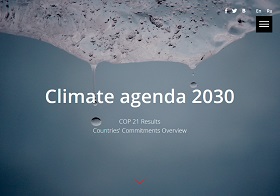
Countries' Commitments Overview
I think it will take a few years for mankind to start truly recognizing the events of this era. It takes 30—50 years for a policy to become ‘solidified’ in history. After this, the underlying processes that determined the course of events can be seen. It’s impossible to be a contemporary and see this. There must be some distance. I was educated as an historian, so I even try to look at the present through the prism of historical criteria. First, mankind always lives in the present without correlating this present to the past or the coming future. Second, we do not make causal links with the synchronicity of particular processes. In general, mankind is not aware that it is living in history.
Therefore, as far as I see it, mankind has no alternative path. What is currently referred to as ‘environmental acceptability’, even if we acknowledge it, has a tremendous impact on the processes that are taking place. There is currently a lot of talk about a green economy. Why? Because serious problems have arisen. The principle of unrestricted growth on a physically restricted planet is a self-contradiction – it’s impossible. Mankind does not have the resources for unlimited growth in a resource-based economy. We need to seek out opportunities for growth without the use of new resources.
Today, the leading corporations are already aware that they can create a competitive edge here. For instance, Michelin has stopped selling tires for heavy-duty mine dump trucks. They lease them. Why? Because it is too costly to manufacture new tires. Business understands that it is becoming increasing advantageous to generate profit by providing a service instead of selling in bulk. The company began servicing wheels, repairing and restoring them and re-leasing them. In doing so, they conserve natural resources and consequently reduce their costs. Boeing also stopped selling engines for large aircraft and now leases them. A new economy is emerging in all industries, albeit quietly for now.
News channels are all focused on acute and pressing problems involving security and politics, and it’s unlikely that anyone would want to read or watch something about manufacturing changes at major corporations when people are dying in Aleppo.
However, we should not take what is happening lightly. Prior to World War I, people also substituted historical processes with news. Today, the news is pushing aside essential changes.
In one of your recent interviews, you speak about the spiritual crisis of modern society. What do you mean by this concept? And is there a painless way out of it? After all, society also experienced a crisis last century prior to the tragic events of two wars.
It’s not that a spiritual crisis will lead to conflict. We have a clearly defined subconscious pre-set that is dictated not only by newsfeeds, but by genetic memory, which is the scariest thing – this includes military confrontation and growing political tensions. The problems are not limited to this alone. A spiritual crisis leads to anthropological changes in people. I am far from moralizing when speaking on the theme of a spiritual crisis. Its cause is not the ‘inferiority’ of modern man, but man’s inability to adapt to the growing changes around the world. Hence, the desire to seek out ‘simple solutions’. A lack of cultural depth leads to losses on the moral scale of values, to the loss of the inability to search for a ‘hierarchy of values’ within oneself and to an understanding of the difficulty of life and the hierarchy of values that can only serve as a system and a beacon in life. As a result, mankind is approaching the breaking point in the development of man as an entity.
Evolution is an accelerating process as almost everyone agrees today. And it’s not just an accelerating process, but a process that accelerates in escalation mode. This means that over a finite amount of time the process speed should have officially reached an infinite speed and all linear projections after this point become impossible.
Scientists working on this theory assumed that all changes impacting human development would converge by roughly 2035. Mankind will live in a state of constant crisis. Development models and tools will change infinitely and rapidly, literally every day.
I think that there are two options: either man will change, which is unlikely, or we will reach a point of bifurcation when civilization splits into two directions. There may be two types of mankind: the ‘network-based’ majority, which has resigned itself to the role of being transformed into part of the ‘global matrix’, and the ‘renegades’ who think for themselves and prefer to retain their individuality. The so-called ‘humans’ and ‘ludens’. This hypothesis was made back in the 1930s by Dutch philosopher Johan Huizinga in his book Man Playing. Further developing this theory, Soviet philosopher Alexander Zinoviev later introduced the concept of ‘humant’. These ideas were also reflected in the works of the Strugatsky brothers and Stanislaw Lem. If humanity is unable to stop its further moral degradation, it may split.
What is your favourite book? And what three books would you recommend that any person read regardless of age, gender or profession?
I have a lot of favourite books. I cannot cite just one. It’s a very long list. First, it would be the Confessions of St. Augustine. I do not know a better work that penetrates the anthropological essence of man. If you understand the language of the time, an attentive reader will see that the book is written with an amazing sense of humour. This book should be re-read at different stages of your life. Second, the stories of Anton Chekhov. He is a highly underappreciated writer, to my mind. He saw man in a different way than Tolstoy or Dostoevsky did. Third, from relatively recent times I would cite Mikhail Bulgakov’s The Master and Margarita. You can always find new facets in this book with each successive reading. And, of course, the works of the Strugatsky brothers and Stanislaw Lem.
Interviewed by Maria Gurova
(no votes) |
(0 votes) |

